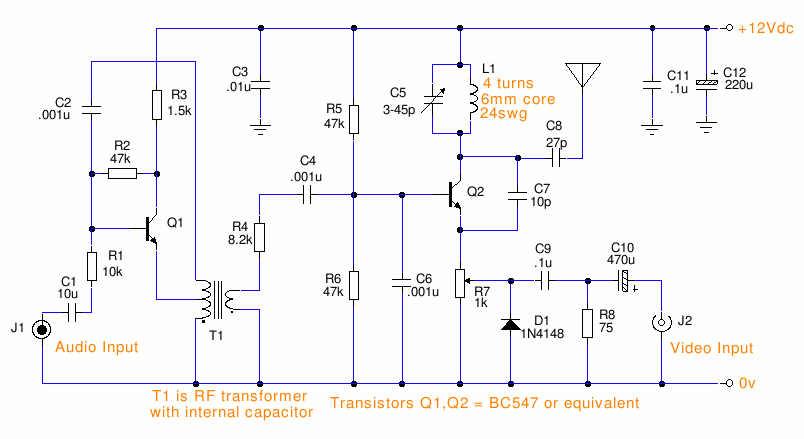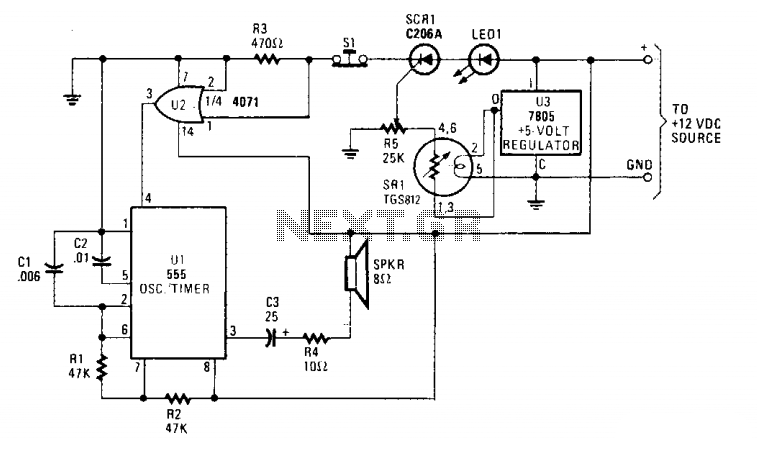
Transmitter Detector for FM Bug Surveillance

The circuit was constructed using a few components powered by a 9 V battery for sensing the presence of bugs transmitting within the frequency modulation range. Frequency Modulation (FM) transmits its signal or information over a carrier wave by changing its frequency, but it can also be considered a special case of phase modulation, where the carrier phase modulation is the time integral of the FM modulating signal. A transmitter is an electronic device that can produce or amplify a carrier wave signal, modulates it with a significant signal, and radiates the resulting signal from an antenna, which is utilized in television, telecommunications, and radio. A Field Effect Transistor (FET) is used for amplifying weak signals by controlling the current and the shape of an electric field, where the flow of current or the conductivity of material is only through a single type of semiconductor material. Bugs are also known as listening devices, wireless microphones, transmitters, and telephone gadgets that are easy to use and very effective. The FM bugs are typically designed to work in the commercial range of 87 MHz to 108 MHz. The bug detectors will pick up almost anything that transmits in this frequency band. In some cases, when a bug made of a sensitive microphone is broadcasting in close proximity, it may produce a feedback whistle in the detector. The inductor used in the circuit has a value of 0.389 µH molded as an RF coil. It is tuned for broadband and possesses a quality factor of about 170. The coil picks up the signal and is rectified by the OA91 gold-bonded germanium diode, which has low power consumption and a very low noise level. The minimal DC voltage will give deflection on the meter, having 250 µA full-scale deflection while reversing the bias on the FET. For higher sensitivity, the meter used should contain a full-scale deflection of 50 µA or 100 µA. The FET used in this circuit can be the 2N3819 or MPF102, which offers good performance at mid to high frequencies and is a low-cost type. It has low noise and leakage, very high system sensitivity, high-speed switching capability, wideband high gain at 100 MHz, high low-level signal amplification, and high quality of amplification. The use of the detector is applied in a sweeping motion while being carried around a room, and when a bug is nearby, a feedback whistle will be heard. Even a small battery transmitter can cause deflection of the meter from a distance. During the construction of an FM transmitter, this detector will provide a valuable part of the equipment. Bugs or listening devices can be utilized in several forms of equipment such as phone line bugs, credit card UHF bugs, pen-style UHF bugs, long-range UHF bugs, calculator-style UHF bugs, phone line FM bugs, powerboard bugs, wall contact microphones, super directional listening sets, inline microphones, digital voice recorders, monocular scopes, and wristwatch walkie-talkies. Bugs can also come in the form of radio transmitters that transmit sounds over the radio frequency; in the form of lasers that aim a laser with sine waves on an object and analyze the returned laser beam; in the form of contact microphones and speakers, which both contain a diaphragm to interact with the air, a power source, and two coils of fine wire; in the form of hardwired devices like stereo speakers, power lines, wired intercoms, phone lines, and LAN cabling; in the form of visible light transmitters that function by modifying the voltage flowing in a light source; and in the form of infrared transmitters that utilize infrared lights to transmit sound rather than radio waves. There are numerous detection tools that identify wiretaps, wireless video transmitters, radio interference, electronic eavesdropping, and bugs. In testing telephone trunks for wiretaps, a device known as a time domain reflector (TDR) is used, which acts as radar for wiretaps.
The circuit described functions as a bug detector, leveraging the principles of frequency modulation to identify unauthorized transmission devices. The primary power source is a 9 V battery, which provides the necessary energy for the circuit's operation. The FM modulation range utilized in this application spans from 87 MHz to 108 MHz, a frequency band commonly associated with commercial radio broadcasts and, consequently, potential bugging devices.
The circuit employs a Field Effect Transistor (FET), specifically the 2N3819 or MPF102, chosen for their low noise characteristics and ability to amplify weak signals effectively. The FET's role is critical in enhancing the sensitivity of the detector, allowing it to respond to even minimal signal transmissions. The inductor, with a specification of 0.389 µH, is molded as an RF coil and is designed to optimize signal reception through its high quality factor of approximately 170, ensuring effective broadband tuning.
Signal rectification is achieved using an OA91 gold-bonded germanium diode, which is known for its low power consumption and minimal noise contribution. The output of this rectification process is then directed to a meter, which indicates the presence of a signal. The meter can be calibrated for different full-scale deflections, with options of 50 µA or 100 µA being preferred for enhanced sensitivity.
The operational principle of the bug detector involves sweeping the device around a room. When an active bug is detected within the vicinity, the circuit generates a feedback whistle, alerting the user to the presence of a potential listening device. This feedback mechanism is crucial for practical applications in surveillance and counter-surveillance operations.
Additionally, the circuit's design allows for versatility in detecting various types of bugs, ranging from traditional wireless microphones to sophisticated infrared transmitters. The comprehensive nature of the bug detection capabilities makes this circuit an invaluable tool in both personal and professional settings, where privacy and security are of utmost concern. The integration of advanced components and careful tuning of the circuit parameters contribute to its effectiveness in identifying unauthorized transmissions.The circuit was constructed using a few components that is powered by a 9 V battery for sensing the presence of bugs transmitting within the frequency modulation range. Frequency Modulation (FM) transmits its signal or information over a carrier wave by changing its frequency but it can also be taken into account as a special case of phase mod
ulation where the carrier phase modulation is the time integral of the FM modulating signal Transmitter an electronic device that can produce or amplify a carrier wave signal, modulates it with a significant signal, and radiates the resulting signal from an antenna which are being utilized in television, telecommunications, and radio Field Effect Transistor (FET) used for amplifying weak signals by controlling the current and the shape of an electric field where the flow of current or the conductivity of material is only through a single type of semiconductor material Bugs are also known as listening devices, wireless microphones, transmitters and telephone gadgets which are easy to use and very effective. The FM bugs are typically designed to work in the commercial range of 87 MHz to 108 MHz. The bug detectors will pickup almost anything that transmits in this frequency band. In some case, when a bug made of sensitive microphone is broadcasting in close proximity, it may produce a feedback whistle in the detector.
The inductor used in the circuit has a value of 0. 389 uH molded as an RF coil. It is tuned for broadband and possesses a quality factor at about 170. The coil picks up the signal and is rectified by the OA91 gold bonded germanium diode. It has low power consumption and very low noise level. The minimal DC voltage will give the deflection on the meter, having 250 uA full scale deflection, while reversing the bias on the FET. For higher sensitivity, the meter to be used should contain a full scale deflection of 50 uA or 100 uA.
The FET used in this circuit can be the 2N3819 or MPF102 which offers good performance at mid to high frequencies and a low cost type. It has low noise and leakage, very high system sensitivity, high speed switching capability, wideband high gain at 100 MHz, high low-level signal amplification and high quality of amplification.
The use of the detector is applied in a sweeping motion while being carried around a room, and when a bug is nearby, a feedback whistle will be heard. Even a small battery transmitter can cause deflection the meter from a distance away from it. During the construction of an FM transmitter, this detector will provide a valuable part of the equipment.
Bugs or listening devices can be utilized in several forms of equipments such as phone line bug, credit card UHF bug, pen style UHF bug, long range UHF bug, calculator style UHF bug, phone line FM bug, powerboard bug, wall contact microphone, super directional listening set, inline microphone, digital voice recorder, monocular scope and wrist watch walkie talkie. Bugs can also come in the form of radio transmitters which transmits sounds over the radio frequency; in the form of lasers where it aims a laser that has sine waves on an object and analyzing the returned laser beam; in the form of contact microphones and speakers which both contains a diaphragm to interact with the air, a power source, and 2 coils of fine wire; in the form of hardwired devices like stereo speakers, power lines, wired intercoms, phone lines and LAN cabling; in the form of visible light transmitters which functions by modifying the voltage flowing in a light source; and in the form of infrared transmitters which utilizes infrared lights to transmit sound rather than radio waves.
There are quite a lot of detection tools that detect wiretaps, wireless video transmitters, radio interference, electronic eavesdropping, and bugs. In testing the telephone trunks for wiretaps, a device known as time domain reflector (TDR) is used which acts as radar for wi
🔗 External reference
The circuit described functions as a bug detector, leveraging the principles of frequency modulation to identify unauthorized transmission devices. The primary power source is a 9 V battery, which provides the necessary energy for the circuit's operation. The FM modulation range utilized in this application spans from 87 MHz to 108 MHz, a frequency band commonly associated with commercial radio broadcasts and, consequently, potential bugging devices.
The circuit employs a Field Effect Transistor (FET), specifically the 2N3819 or MPF102, chosen for their low noise characteristics and ability to amplify weak signals effectively. The FET's role is critical in enhancing the sensitivity of the detector, allowing it to respond to even minimal signal transmissions. The inductor, with a specification of 0.389 µH, is molded as an RF coil and is designed to optimize signal reception through its high quality factor of approximately 170, ensuring effective broadband tuning.
Signal rectification is achieved using an OA91 gold-bonded germanium diode, which is known for its low power consumption and minimal noise contribution. The output of this rectification process is then directed to a meter, which indicates the presence of a signal. The meter can be calibrated for different full-scale deflections, with options of 50 µA or 100 µA being preferred for enhanced sensitivity.
The operational principle of the bug detector involves sweeping the device around a room. When an active bug is detected within the vicinity, the circuit generates a feedback whistle, alerting the user to the presence of a potential listening device. This feedback mechanism is crucial for practical applications in surveillance and counter-surveillance operations.
Additionally, the circuit's design allows for versatility in detecting various types of bugs, ranging from traditional wireless microphones to sophisticated infrared transmitters. The comprehensive nature of the bug detection capabilities makes this circuit an invaluable tool in both personal and professional settings, where privacy and security are of utmost concern. The integration of advanced components and careful tuning of the circuit parameters contribute to its effectiveness in identifying unauthorized transmissions.The circuit was constructed using a few components that is powered by a 9 V battery for sensing the presence of bugs transmitting within the frequency modulation range. Frequency Modulation (FM) transmits its signal or information over a carrier wave by changing its frequency but it can also be taken into account as a special case of phase mod
ulation where the carrier phase modulation is the time integral of the FM modulating signal Transmitter an electronic device that can produce or amplify a carrier wave signal, modulates it with a significant signal, and radiates the resulting signal from an antenna which are being utilized in television, telecommunications, and radio Field Effect Transistor (FET) used for amplifying weak signals by controlling the current and the shape of an electric field where the flow of current or the conductivity of material is only through a single type of semiconductor material Bugs are also known as listening devices, wireless microphones, transmitters and telephone gadgets which are easy to use and very effective. The FM bugs are typically designed to work in the commercial range of 87 MHz to 108 MHz. The bug detectors will pickup almost anything that transmits in this frequency band. In some case, when a bug made of sensitive microphone is broadcasting in close proximity, it may produce a feedback whistle in the detector.
The inductor used in the circuit has a value of 0. 389 uH molded as an RF coil. It is tuned for broadband and possesses a quality factor at about 170. The coil picks up the signal and is rectified by the OA91 gold bonded germanium diode. It has low power consumption and very low noise level. The minimal DC voltage will give the deflection on the meter, having 250 uA full scale deflection, while reversing the bias on the FET. For higher sensitivity, the meter to be used should contain a full scale deflection of 50 uA or 100 uA.
The FET used in this circuit can be the 2N3819 or MPF102 which offers good performance at mid to high frequencies and a low cost type. It has low noise and leakage, very high system sensitivity, high speed switching capability, wideband high gain at 100 MHz, high low-level signal amplification and high quality of amplification.
The use of the detector is applied in a sweeping motion while being carried around a room, and when a bug is nearby, a feedback whistle will be heard. Even a small battery transmitter can cause deflection the meter from a distance away from it. During the construction of an FM transmitter, this detector will provide a valuable part of the equipment.
Bugs or listening devices can be utilized in several forms of equipments such as phone line bug, credit card UHF bug, pen style UHF bug, long range UHF bug, calculator style UHF bug, phone line FM bug, powerboard bug, wall contact microphone, super directional listening set, inline microphone, digital voice recorder, monocular scope and wrist watch walkie talkie. Bugs can also come in the form of radio transmitters which transmits sounds over the radio frequency; in the form of lasers where it aims a laser that has sine waves on an object and analyzing the returned laser beam; in the form of contact microphones and speakers which both contains a diaphragm to interact with the air, a power source, and 2 coils of fine wire; in the form of hardwired devices like stereo speakers, power lines, wired intercoms, phone lines and LAN cabling; in the form of visible light transmitters which functions by modifying the voltage flowing in a light source; and in the form of infrared transmitters which utilizes infrared lights to transmit sound rather than radio waves.
There are quite a lot of detection tools that detect wiretaps, wireless video transmitters, radio interference, electronic eavesdropping, and bugs. In testing the telephone trunks for wiretaps, a device known as time domain reflector (TDR) is used which acts as radar for wi
🔗 External reference





